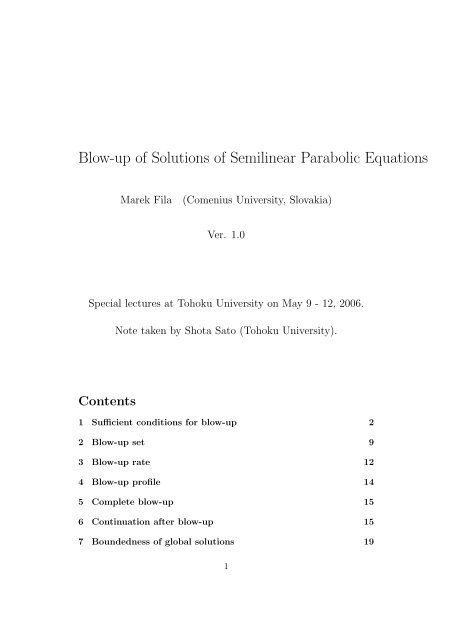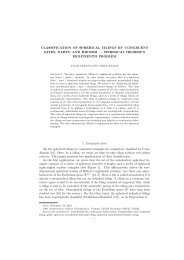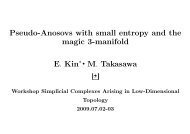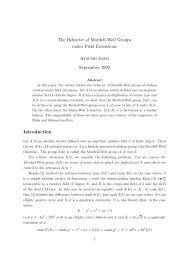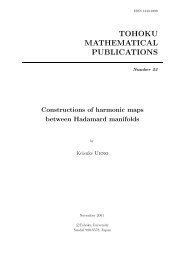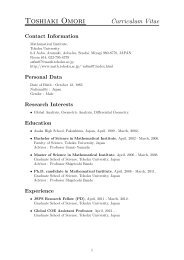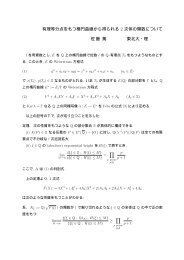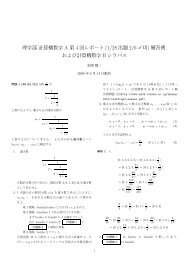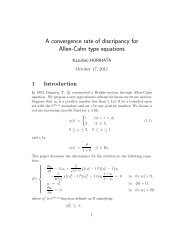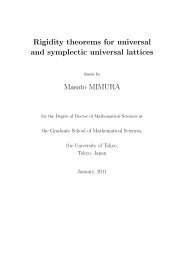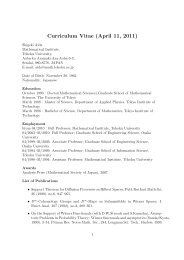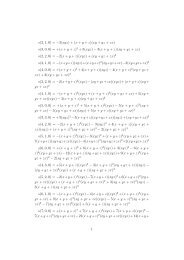Blow-up of Solutions of Semilinear Parabolic Equations
Blow-up of Solutions of Semilinear Parabolic Equations
Blow-up of Solutions of Semilinear Parabolic Equations
Create successful ePaper yourself
Turn your PDF publications into a flip-book with our unique Google optimized e-Paper software.
<strong>Blow</strong>-<strong>up</strong> <strong>of</strong> <strong>Solutions</strong> <strong>of</strong> <strong>Semilinear</strong> <strong>Parabolic</strong> <strong>Equations</strong><br />
Marek Fila<br />
(Comenius University, Slovakia)<br />
Ver. 1.0<br />
Special lectures at Tohoku University on May 9 - 12, 2006.<br />
Note taken by Shota Sato (Tohoku University).<br />
Contents<br />
1 Sufficient conditions for blow-<strong>up</strong> 2<br />
2 <strong>Blow</strong>-<strong>up</strong> set 9<br />
3 <strong>Blow</strong>-<strong>up</strong> rate 12<br />
4 <strong>Blow</strong>-<strong>up</strong> pr<strong>of</strong>ile 14<br />
5 Complete blow-<strong>up</strong> 15<br />
6 Continuation after blow-<strong>up</strong> 15<br />
7 Boundedness <strong>of</strong> global solutions 19<br />
1
1 Sufficient conditions for blow-<strong>up</strong><br />
In this section, we consider blow-<strong>up</strong> <strong>of</strong> solutions <strong>of</strong> the problem<br />
⎧<br />
⎨ u t = ∆u + f(u), x ∈ Ω,<br />
(F) u = 0, x ∈ ∂Ω, (if ∂Ω ≠ ∅)<br />
⎩<br />
u(x, 0) = u 0 (x), x ∈ Ω.<br />
where Ω is a bounded or unbounded domain in R N , N ≥ 1, u 0 is continuous<br />
and u 0 ∈ L ∞ (Ω). We begin with the fundamental result concerning the<br />
existence <strong>of</strong> solutions.<br />
Theorem 1. If f ∈ C 1 , then (F) has a unique (classical) solution u defined<br />
for t ∈ [0, T ), 0 < T ≤ ∞. If T < ∞, then ‖u(·, t)‖ ∞ → ∞ as t → T and u<br />
is said to blow <strong>up</strong> at time T .<br />
Idea <strong>of</strong> pro<strong>of</strong>. Let e t∆ be the heat semigro<strong>up</strong> in Ω with the Dirichlet boundary<br />
condition, that is, u = e t∆ u 0 is the solution <strong>of</strong><br />
u t = ∆u in Ω × (0, ∞),<br />
u = 0 on ∂Ω × (0, ∞),<br />
u(x, 0) = u 0 (x) in Ω.<br />
In particular, if Ω = R N , then<br />
(e t∆ u 0 )(x) = (4πt) − N 2<br />
∫<br />
|x −<br />
)<br />
y|2<br />
u 0 (y) exp<br />
(− dy.<br />
R 4t<br />
N<br />
By using e t∆ , the problem (F) is converted into the integral equation<br />
u(·, t) = e t∆ u 0 +<br />
∫ t<br />
0<br />
e (t−s)∆ f(u(·, s))ds.<br />
With the Banach fixed point theorem, a unique solution is obtained, and the<br />
solution can be continued as long is it is bounded.<br />
q.e.d.<br />
Next, we give a sufficient condition for the blow<strong>up</strong> <strong>of</strong> solutions.<br />
Theorem 2 (Kaplan, 1963 [24]). Let Ω be bounded. Let λ 1 , ϕ 1 denote the<br />
first eigenvalue and eigenfunction <strong>of</strong> −∆ with the Dirichlet boundary condition,<br />
that is,<br />
∆ϕ 1 + λ 1 ϕ 1 = 0 in Ω,<br />
ϕ 1 = 0<br />
∫<br />
on ∂Ω,<br />
ϕ 1 > 0 in Ω, ϕ Ω 1(x)dx = 1.<br />
2
Assume that f : [0, ∞) → [0, ∞) is convex, f(u) > 0 for u > 0, and<br />
< ∞. Define g(u) = f(u) − λ 1u and let A be the l arger root <strong>of</strong><br />
∫ ∞<br />
1<br />
du<br />
f(u)<br />
g(u) = 0 if it has a root. S<strong>up</strong>pose that u 0 ≥ 0 and that ∫ Ω ϕ(x)u 0(x)dx > A<br />
if g(u) = 0 has a root, otherwise u 0 ≢ 0. Then u blows <strong>up</strong> in finite time.<br />
Pro<strong>of</strong>. Multiplying u t = ∆u + f(u) by ϕ 1 and integrating over Ω, we have<br />
∫<br />
∫ ∫<br />
d<br />
uϕdx = −λ 1 uϕdx + f(u)ϕdx<br />
dt Ω<br />
Ω<br />
Ω<br />
∫<br />
∫<br />
≥ −λ 1 uϕdx + f( uϕdx)<br />
by the Jensen inequality. Set<br />
∫<br />
y(t) :=<br />
Then y(t) satisfies<br />
Ω<br />
Ω<br />
uϕ 1 dx.<br />
y ′ ≥ −λ 1 y + f(y) = g(y).<br />
By assumption that f is convex and ∫ ∞<br />
1<br />
dy<br />
f(y)<br />
f(u)<br />
lim<br />
u→∞ u = ∞.<br />
Then there exists U > A such that for u ≥ U<br />
It follows that<br />
This completes the pro<strong>of</strong>.<br />
t ≤<br />
≤<br />
≤<br />
∫ y(t)<br />
y(0)<br />
∫ ∞<br />
y(0)<br />
∫ U<br />
y(0)<br />
< ∞.<br />
Remark 1. The assumption ∫ ∞<br />
1<br />
f(u) > 2λ 1 u.<br />
dy<br />
g(y)<br />
dy<br />
g(y)<br />
∫<br />
dy ∞<br />
g(y) +<br />
U<br />
Ω<br />
< ∞, we obtain<br />
2<br />
f(y) dy<br />
du<br />
< ∞ is necessary. Indeed, if ∫ ∞<br />
f(u) 1<br />
q.e.d.<br />
du<br />
= f(u)<br />
∞, then the solution <strong>of</strong> v t = f(v), v(0) = ‖u 0 ‖ ∞ is a global s<strong>up</strong>ersolution for<br />
u.<br />
3
Remark 2. The assumption ∫ ∞ du<br />
< ∞ is not sufficient for blow-<strong>up</strong>, if f<br />
1 f(u)<br />
is not convex. (See Fila, Ninomiya and Vázquez [8]).<br />
Remark 3. The pro<strong>of</strong> does not necessarily imply that y(t) → ∞ as t → T .<br />
When f(u) = u p , there appears a critical exponent for the blow<strong>up</strong> and<br />
global existence <strong>of</strong> positive solutions.<br />
Theorem 3 (Fujita, 1966 [12]). Consider the equation<br />
u t = ∆u + u p , x ∈ R N , p > 1.<br />
(i) If p < 1 + 2 , all positive solutions blow <strong>up</strong>.<br />
N<br />
(ii) If p > 1 + 2 , there exist both blowing <strong>up</strong> and global positive solutions.<br />
N<br />
Hayakawa, 1973 [21], Kobayashi, Sirao, Tanaka, 1977 [25]: The critical<br />
case p = 1 + 2 is as (i).<br />
N<br />
Why is p = 1 + 2 critical? The following is an intuitive explanation.<br />
N<br />
The fundamental solution <strong>of</strong> u t = ∆u decays like t − N 2 , while the solution <strong>of</strong><br />
u t = u p is given by C(T − t) − 1<br />
p−1 . They are balanced if<br />
N<br />
2 = 1<br />
p − 1 ⇔ p = 1 + 2 N .<br />
Better explanation is as follows. Define v(y, s) = e s<br />
p−1 u(e<br />
s<br />
2 y, e s − 1). Then v<br />
solves<br />
v s = ∆v + y 2 · ∇v + 1<br />
p − 1 v + vp , y ∈ R N , s > 0.<br />
Here the principal eigenvalue <strong>of</strong> Lv := ∆v + y · ∇v in 2 L2 ρ with ρ(y) = e |y|2<br />
4<br />
is given by λ 1 = − N . This implies that the trivial solution v ≡ 0 is stable<br />
2<br />
if N > 1 , and is unstable if N < 1 . As a consequence <strong>of</strong> instability, the<br />
2 p−1 2 p−1<br />
solution blows <strong>up</strong>.<br />
Next, consider<br />
u t = ∆u + f(u), x ∈ Ω,<br />
u = 0,<br />
x ∈ ∂Ω,<br />
u(x, 0) = u 0 (x),<br />
where Ω is a bounded domain. For v ∈ C 1 (Ω), define<br />
E(v) = 1 ∫<br />
∫<br />
|∇v| 2 dx − F (v)dx, F (v) =<br />
2<br />
Ω<br />
Ω<br />
4<br />
∫ v<br />
0<br />
f(u)du.
Lemma 1. If u is a solution for t ∈ [0, T ), then<br />
d<br />
dt<br />
∫Ω<br />
E(u(·, t)) = − u 2 t dx ≤ 0.<br />
Pro<strong>of</strong>. We calculate<br />
∫<br />
d<br />
dt<br />
∫Ω<br />
E(u(·, t)) = ∇u · ∇u t dx − f(u)u t dx<br />
Ω<br />
∫<br />
∫<br />
= − (∆u + f(u))u t dx = − u 2 t dx ≤ 0.<br />
Ω<br />
Ω<br />
q.e.d.<br />
Theorem 4 (Levine, 1973 [28]). Let Ω be bounded and f(u) = |u| p−1 u, p ><br />
1. If u 0 ∈ C 1 (Ω) satisfies E(u 0 ) < 0, then u blows <strong>up</strong> in finite time .<br />
Pro<strong>of</strong>. Multiplying u t = ∆u + |u| p−1 u by u and integrating over Ω, we have<br />
∫ ∫ ∫<br />
uu t dx = u∆udx + |u| p+1 dx,<br />
and hence<br />
Ω<br />
∫<br />
1 d<br />
2 dt<br />
Ω<br />
Ω<br />
∫<br />
∫<br />
u 2 dx = − |∇u| 2 dx +<br />
Ω<br />
= −2E(u) + p − 1 ∫<br />
p + 1<br />
From the Hölder inequality, it follows that<br />
∫<br />
∫<br />
∫<br />
|u| p+1 dx = (u 2 ) p+1<br />
2 dx ≥ C(Ω)(<br />
Ω<br />
Ω<br />
Ω<br />
Ω<br />
Ω<br />
|u| p+1 dx<br />
Define y(t) := ∫ Ω u2 dx. Then the function y(t) satisfies<br />
1<br />
2 y′ > C(Ω) −1 p − 1<br />
p + 1 y p+1<br />
2 .<br />
|u| p+1 dx.<br />
Ω<br />
u 2 dx) p+1<br />
2 .<br />
Since y cannot exist globally, the solution u cannot exists globally either.<br />
q.e.d.<br />
Consider the stationary problem<br />
(S)<br />
{<br />
vxx + v p = 0, x ∈ (−L, L), L > 0, p > 1,<br />
v(±L) = 0.<br />
5
Theorem 5. For every L > 0 and p > 1, there is a unique positive solution<br />
<strong>of</strong> (S).<br />
Pro<strong>of</strong>. At first, we prove that x = 0 is the only maximum point <strong>of</strong> a positive<br />
solution <strong>of</strong> (S). Assume x = x 0 is a maximum point <strong>of</strong> a positive solution <strong>of</strong><br />
(S), v(x 0 ) = M > 0. Since a positive solution <strong>of</strong> (S) is concave by v xx < 0<br />
on (−1, 1), this maximum point is unique. Multiplying v xx + v p = 0 by v x ,<br />
we have<br />
v x v xx + v x v p = 0,<br />
( 1 2 v2 x + 1<br />
p + 1 vp+1 ) x = 0.<br />
Integrating this over [x 0 , x], x > x 0 , by v x (x 0 ) = 0, we obtain<br />
By v x ≤ 0 on [x 0 , L], we have<br />
1<br />
2 v2 x + 1<br />
p + 1 vp+1 = 1<br />
p + 1 M p+1 .<br />
vx 2 = 2<br />
p + 1 (M p+1 − v p+1 ),<br />
√ 2 √<br />
v x = − M<br />
p+1<br />
− v<br />
p + 1<br />
p+1 .<br />
By separation <strong>of</strong> variables, it follows that for x 0 ≤ x ≤ L<br />
∫ M<br />
v(x)<br />
By v(L) = 0, we obtain<br />
∫ M<br />
0<br />
dv<br />
√<br />
M<br />
p+1<br />
− v p+1 = − √ 2<br />
p + 1 dx,<br />
√<br />
dw<br />
2<br />
√<br />
M<br />
p+1<br />
− w = p+1 p + 1 (x − x 0).<br />
√<br />
dw<br />
2<br />
√<br />
M<br />
p+1<br />
− w = p+1 p + 1 (L − x 0).<br />
Similarly, by v x ≥ 0 on [L, x 0 ], we obtain<br />
∫ M<br />
It follows that x 0 = 0.<br />
0<br />
√<br />
dw<br />
2<br />
√<br />
M<br />
p+1<br />
− w = p+1 p + 1 (L + x 0).<br />
6
Next, we prove that a positive solution <strong>of</strong> (S) is even. As above, we have<br />
It follows that<br />
Since<br />
∫ M<br />
v(x)<br />
∫ M<br />
v(x)<br />
∫ M<br />
√<br />
dw<br />
2<br />
√<br />
M<br />
p+1<br />
− w = x for 0 ≤ x ≤ L,<br />
p+1 p + 1<br />
√<br />
dw<br />
2<br />
√<br />
M<br />
p+1<br />
− w = − x for 0 ≤ x ≤ L.<br />
p+1 p + 1<br />
v(x)<br />
∫<br />
dw<br />
M<br />
√<br />
M<br />
p+1<br />
− w = p+1<br />
∫ M<br />
α<br />
v(−x)<br />
dw<br />
√<br />
M<br />
p+1<br />
− w p+1<br />
dw<br />
√<br />
M<br />
p+1<br />
− w p+1 .<br />
is monotone decreasing on [0, M] with α, it follows that v(x) = v(−x), and<br />
so a positive solution <strong>of</strong> (S) is even.<br />
Finally, as a solution <strong>of</strong> (S) is even, it is sufficient to prove that there is<br />
a unique positive solution <strong>of</strong><br />
(SR)<br />
{<br />
vxx + v p = 0, x ∈ (0, L),<br />
v x (0) = v(L) = 0.<br />
A positive solution <strong>of</strong> (SR) can be obtained as a solution<br />
Define<br />
(SR) ′ {<br />
vxx + v p = 0, x > 0,<br />
v x (0) = 0, v(0) = M > 0.<br />
ϕ(M) :=<br />
∫ M<br />
0<br />
dw<br />
√<br />
M<br />
p+1<br />
− w p+1 .<br />
√<br />
Then it is sufficient to show for every L > 0 that ϕ(M) =<br />
positive solution. We calculate ϕ(M) as<br />
ϕ(M) =<br />
∫ M<br />
and we change the variable w M<br />
0<br />
∫<br />
dw<br />
M<br />
p+1<br />
−<br />
√ = M 2<br />
M<br />
p+1<br />
− wp+1 0<br />
ϕ(M) = M − p−1<br />
2<br />
= y, dw = Mdy to obtain<br />
7<br />
∫ 1<br />
0<br />
dy<br />
√<br />
1 − y<br />
p+1 ,<br />
2<br />
p+1<br />
dw<br />
√<br />
1 − (<br />
w<br />
M )p+1 ,<br />
L has unique
where ∫ 1<br />
√<br />
dy<br />
0<br />
then it follows that<br />
is a constant dependent on p. Define C<br />
1−y p+1 p := ∫ 1<br />
0<br />
ϕ(M) = C p M − p−1<br />
2 .<br />
√<br />
Since ϕ is monotone decreasing and the range <strong>of</strong> ϕ is (0, ∞), ϕ(M) =<br />
has a unique positive solution for every L > 0.<br />
Theorem 6. Consider the problem<br />
⎧<br />
⎨ u t = u xx + u p , |x| < 1, p > 1,<br />
(P) u = 0, |x| = 1,<br />
⎩<br />
u(x, 0) = u 0 (x), |x| < 1.<br />
dy<br />
√1−y p+1 ,<br />
2<br />
L p+1<br />
q.e.d.<br />
If u 0 (x) ≥ v(x), u 0 ≢ v(x), v is the solution <strong>of</strong> (S), then u blows <strong>up</strong> in finite<br />
time.<br />
Pro<strong>of</strong>. By the maximum principle, if τ > 0, then u(x, τ) > v(x) for |x| < 1.<br />
Moreover u x (1, τ) < v x (1) and u x (−1, τ) > v x (−1). Hence there is k > 1<br />
such that u(x, τ) > kv(x).<br />
Thus, it is suffcient to consider the case where u 0 (x) = kv(x), k > 1. In<br />
this case, we have<br />
(u t ) t = (u t ) xx + pu p−2 u t , |x| < 1,<br />
u t = 0, |x| = 1,<br />
u t (x, 0) = kv xx + k p v p > k(v xx + v p ) = 0.<br />
By the maximum principle, we obtain u t ≥ 0 as long as u exists.<br />
S<strong>up</strong>pose u is global. If u is bounded, there exists a solution w(x) <strong>of</strong> (S)<br />
such that<br />
u(x, t) → w(x) as t → ∞, w(x) > v(x), |x| < 1,<br />
this is a contradiction with Theorem 5.<br />
If u is unbounded, then<br />
u(x, t) ≡ u(−x, t), u x (x, t) < 0 for x ∈ [0, 1),<br />
and either<br />
or<br />
(i) lim<br />
t→∞<br />
u(x, t) < ∞, x ∈ (a, 1], a ∈ (0, 1],<br />
(ii) lim<br />
t→∞<br />
u(x, t) = ∞, |x| < 1,<br />
8
occurs. In case (i), there exists w such that<br />
lim<br />
t→∞<br />
(S ∗ )<br />
u(x, t) = w(x), x ∈ (a, 1],<br />
{<br />
wxx + w p = 0,<br />
w(a) = ∞, w(1) = 0,<br />
but (S ∗ ) does not have a solution, because w is concave. In case (ii), there<br />
is t 0 > 0 such that<br />
∫ 1<br />
−1<br />
u(x, t 0 )ϕ(x)dx > λ 1<br />
p−1<br />
1 (= A in Theorem 2),<br />
this is a contradiction with Theorem 2.<br />
q.e.d.<br />
2 <strong>Blow</strong>-<strong>up</strong> set<br />
Definition 1. Let u blow <strong>up</strong> in finite time T > 0. Then x 0 ∈ Ω is a blow<strong>up</strong><br />
point if u(x n , t n ) → ∞ for some {(x n , t n )} ∞ n=1 ⊂ Ω × (0, T ) such that<br />
(x n , t n ) → (x 0 , T ) as n → ∞. The blow-<strong>up</strong> set B is the set <strong>of</strong> all blow-<strong>up</strong><br />
points.<br />
Weissler, 1984 [37]: If u is the solution <strong>of</strong> (P) with u 0 (x) = kv(x), where<br />
v(x) is the unique stationary solution and k > 1, then B = {0}.<br />
Theorem 7 (Friedman and McLeod, 1985 [11]). Consider the problem<br />
u t = u rr + N−1 u<br />
r r + u p , (r, t) ∈ (0, R) × (0, ∞), p > 1,<br />
u(R, t) = u r (0, t) = 0, t ∈ (0, ∞),<br />
u(r, 0) = u 0 (r), r ∈ [0, R].<br />
Let u 0 ∈ C 2 ([0, R]), (u 0 ) r < 0 for r ∈ (0, R], (u 0 ) rr < 0. Then for any<br />
q ∈ (1, p), there is K = K(u 0 , p, q, R) such that<br />
(If T < ∞, then B = {0}.)<br />
u(r, t) ≤ Kr − 2<br />
q−1 for t ∈ (0, T ).<br />
Pro<strong>of</strong>. Define<br />
Assuming<br />
J(r, t) = r N−1 u r + c(r)F (u).<br />
s<strong>up</strong><br />
r>0<br />
c(r)<br />
r N < ∞,<br />
9
we claim that<br />
J t + N − 1 J r − J rr + b(r, t)J = −c(r)A(r, t),<br />
r<br />
b(r, t) − bounded for 0 ≤ r ≤ R,<br />
A(r, t) = pu p−1 F − u p F ′ +<br />
c2<br />
r F ′ F 2 − 2c′<br />
2N−2 r F ′ F +<br />
(<br />
N−1<br />
+ c ′′ − N − 1 ) F<br />
c ′<br />
r c ,<br />
2(N − 1)<br />
cF ′ F<br />
r N<br />
and if we choose c(r) = ɛr N+δ , ɛ, δ > 0, F (u) = u γ , 1 < γ < p, then for<br />
any γ ∈ (1, p), δ > 0, there is ɛ > 0 such that A > 0.<br />
Pro<strong>of</strong> <strong>of</strong> claim. We compute<br />
The function<br />
J t + N − 1 J r − J rr + c(r)A(r, t)<br />
r<br />
}<br />
=<br />
{pu p−1 + 2(N − 1)cF ′ r −N − c3<br />
r 2N−2 (rN−1 u r + cF ) J.<br />
b(r, t) = pu p−1 + 2(N − 1)cF ′ r −N − (r N−1 u r + cF )c 3 /r 2N−2<br />
is bounded for 0 < r < R by the assumption that s<strong>up</strong> r>0 c(r)/r N < ∞. We<br />
choose c(r) = ɛr N+δ , 0 < ɛ < 1, δ > 0, F (u) = u γ , 1 < γ < p. Then we<br />
have<br />
A(r, t) = u γ {(p − γ)u p−1 −2ɛ(δ + 1)γr δ u γ−1<br />
+ ɛ 2 γ(γ − 1)r 2δ+2 u 3γ−2 + (N + δ)δr −2 }.<br />
By p > γ, there exists M > 0 independent <strong>of</strong> ɛ such that if u > M, then<br />
A > 0. With u(R, t) = 0, there is R 0 > 0 independent <strong>of</strong> ɛ such that for<br />
R 0 < r < R, we have<br />
(p − γ)u p−1 − 2ɛ(δ + 1)γr δ u γ−1 + ɛ 2 γ(γ − 1)r 2δ+2 u 3γ−2 + (N + δ)δr −2 > 0,<br />
and A(r, t) > 0 for R 0 < r < R. There is m > 0 such that u(r, t) ><br />
m for 0 < r < R 0 . If u ≤ M, 0 < r < R 0 , then we obtain<br />
A(r, t) ≥ u γ {(p − γ)m p−1 −2ɛ(δ + 1)γr δ M γ−1<br />
+ ɛ 2 γ(γ − 1)r 2δ+2 m 3γ−2 + (N + δ)δr −2 }.<br />
If ɛ is small, then it follows that A(r, t) > 0.<br />
complete.<br />
Consequently, the pro<strong>of</strong> is<br />
q.e.d.<br />
10
Moreover, we have<br />
J(0, t) = 0, J(R, t) ≤ 0.<br />
If ɛ is small, we obtain J(r, 0) ≤ 0. By the maximum principle, it follows<br />
that J ≤ 0 for (r, t) ∈ [0, R] × [0, T ). Then we have<br />
u r ≤ −ɛr 1+δ u γ ,<br />
1<br />
1 − γ (u1−γ ) r ≤ −ɛr 1+δ .<br />
Integrating this over [0, r], we obtain<br />
u 1−γ (r, t) ≥ u 1−γ (r, t) − u 1−γ 1<br />
(0, t) ≥ ɛ(γ − 1)<br />
2 + γ r2+γ ,<br />
u(r, t) ≤ Kr − 2+δ<br />
γ−1 ,<br />
and so we choose γ, δ such that 2+δ<br />
γ−1 = 2<br />
q−1 .<br />
q.e.d.<br />
Remark 4. Theorem 7 holds for f(u) more general than u p . It is essential<br />
that f(u) ≥ Cu log q u, u ≥ U > 1, q > 2.<br />
Remark 5. If f(u) = (u + a) log q (u + a), a > 1, then blow-<strong>up</strong> occurs if and<br />
only if q > 1. This follows from Theorem 2 and Remark 1.<br />
Lacey, 1986 [25]: Consider the problem<br />
u t = ∆u + f(u),<br />
u = 0,<br />
x ∈ Ω − bounded,<br />
x ∈ ∂Ω.<br />
(i) If Ω is large and f(u) = (u + 2) log 2 (u + 2), then there is Ω 0 ⊂ Ω, |Ω 0 | > 0,<br />
Ω 0 ⊂ Ω, such that B = {Ω 0 } (regional blow-<strong>up</strong>), if Ω is small, then B = Ω.<br />
(ii) If f(u) = (u + 2) log q (u + 2), 1 < q < 2, then B = Ω.<br />
Chen and Matano, 1989 [5]: Consider the problem<br />
u t = u xx + f(u), |x| < 1,<br />
u = 0, |x| = 1,<br />
under some assumtion on f. Assume T < ∞, then B consists <strong>of</strong> finite<br />
number <strong>of</strong> points. This number is smaller than or equal to the number <strong>of</strong><br />
local maxima <strong>of</strong> u 0 .<br />
11
Merle, 1992 [30]: Consider the problem<br />
u t = u xx + u p , |x| < 1, p > 1,<br />
u = 0, |x| = 1,<br />
u(x, 0) = u 0 (x), |x| ≤ 1.<br />
Given any positive integer k and −1 < x 1 < · · · < x k < 1, there is u 0 such<br />
that u blows <strong>up</strong> at t = T < ∞ and B = {x 1 , . . . , x k }.<br />
Giga and Kohn, 1989 [18]: Consider the problem<br />
u t = ∆u + u p , x ∈ Ω,<br />
u = 0,<br />
x ∈ ∂Ω,<br />
u(x, 0) = u 0 (|x|) ≥ 0, x ∈ Ω,<br />
where Ω = {|x| < R} ⊂ R N , p > 1 and (N − 2)p < N + 2. Then there is u 0<br />
such that u blows <strong>up</strong> on a sphere B = {|x| = R 0 }, 0 < R 0 < R.<br />
Velázquez, 1993 [36]: Consider the equation<br />
u t = ∆u + u p , x ∈ R N , p > 1, (N − 2)p < N + 2.<br />
Since (N − 1)-dimensional Hausdorff measure is finite in every compact sets,<br />
the dimension <strong>of</strong> B is at most (N − 1) in every compact sets if u ≢ C(T −<br />
t) − 1<br />
p−1 .<br />
3 <strong>Blow</strong>-<strong>up</strong> rate<br />
In this section, we consider the blow-<strong>up</strong> rate <strong>of</strong> solutions for<br />
Define M(t) := max Ω u(·, t), then<br />
u t = ∆u + |u| p−1 u.<br />
M ′ (t) ≤ M p (t), M(t) ≥ ((p − 1)(T − t)) − 1<br />
p−1 .<br />
Definition 2. <strong>Blow</strong>-<strong>up</strong> is <strong>of</strong> type I if (T − t) − 1<br />
p−1 ‖u(·, t)‖∞ ≤ C, otherwise<br />
blow-<strong>up</strong> is <strong>of</strong> type II.<br />
Weissler, 1985 [38]: Assume the condition<br />
(N − 2)p < N + 2, Ω = {|x| < R} ⊂ R N , u − radial, u r , u rr ≤ 0, u t ≥ 0.<br />
12
Then blow-<strong>up</strong> is type I.<br />
Friedman and McLeod, 1985 [11]: <strong>Blow</strong>-<strong>up</strong> is <strong>of</strong> type I, if Ω is bounded,<br />
u, u t ≥ 0 (u 0 ≥ 0, ∆u 0 + u p 0 ≥ 0 in Ω).<br />
Pro<strong>of</strong>. Define J(r, t) = u t − ɛu p for ɛ > 0. Then we have<br />
J t − ∆J − pu p−1 J = ɛp(p − 1)u p−2 |∇u| 2 ≥ 0,<br />
J = 0 on ∂Ω, J ≥ 0 if t = 0.<br />
By the maximum principle, we obtain J ≥ 0 in Ω × (0, T ). It follows that<br />
u t ≥ ɛu p ,<br />
and so we obtain<br />
u(x, t) ≤ ((p − 1)ɛ(T − t)) − 1<br />
p−1 .<br />
q.e.d.<br />
The results on type I blow-<strong>up</strong> are listed as follows:<br />
• Galaktionov and Posashkov, 1986 [13]: N=1.<br />
• Giga and Kohn, 1985 [16], 1989, [18]: Ω = R N or Ω is bounded,<br />
convex and either (i) u ≥ 0, (N −2)p < N +2 or (ii) (3N −4)p < 3N +8.<br />
• Giga, Matsui and Sasayama, 2004 [19], [20]: Ω = R N<br />
bounded, convex, (N − 2)p < N + 2.<br />
or Ω is<br />
• Filippas, Herrrero and Velázquez, 2000 [10]: Ω = {|x| < R}, u<br />
is radial, u r ≥ 0, p = N+2<br />
N−2 .<br />
• Matano and Merle, 2004 [29]: Ω = {|x| < R}, u is radial, p ><br />
N+2<br />
, N > 2, p < p 4<br />
N−2 JL = 1 +<br />
N−4−2 √ if N > 10.<br />
N−1<br />
The results on type II blow<strong>up</strong> are listed as follows:<br />
• Herrero and Velázquez, 1993 [22]: There are solutions with type<br />
II blow-<strong>up</strong> if p > p JL .<br />
• Mizogichi, 2004 [32]: The same result as [22] with a simlar but<br />
shorter pro<strong>of</strong>.<br />
13
In order to explain why type II blow-<strong>up</strong> occurs, we define<br />
w(y, s) = (T − t) 1<br />
x<br />
p−1 u(x, t), y = √ , s = − log(T − t).<br />
T − t<br />
Then w satisfies<br />
(W) w s = ∆w − y 2 ∇w + wp − 1<br />
p − 1 w, y ∈ RN , s > − log T.<br />
There is a solution w such that<br />
w(y, s) → w ∗ (y) as s → ∞,<br />
where w ∗ (y) is the singular stationary solution C|y| − 2<br />
p−1 .<br />
4 <strong>Blow</strong>-<strong>up</strong> pr<strong>of</strong>ile<br />
In this section, we consider behavior at the blow-<strong>up</strong> time <strong>of</strong> solution for<br />
u t = ∆u + u p , p > 1.<br />
We note that (W) has a stationary solution k = (p − 1) − 1<br />
p−1 .<br />
Giga and Kohn, 1987 [17]: The constant k is the only positive bounded<br />
stationary solution <strong>of</strong> (W). Moreover w(y, s) → k as s → ∞ uniformly for<br />
|y| ≤ C, C > 0.<br />
Herrero and Velázquez, 1992 [23]: Consider the problem<br />
u t = u xx + u p , x ∈ R,<br />
u(x, 0) = u 0 (x) ≥ 0,<br />
where u 0 is continuous, bounded, u 0 ≢ C and such that u blows <strong>up</strong> at T < ∞<br />
with the blow<strong>up</strong> set B = {0}. Then, one <strong>of</strong> the following alternatives holds:<br />
( |x|<br />
2 ) 1 (<br />
p−1<br />
8p<br />
) 1<br />
p−1<br />
(a) lim<br />
u(x, T ) =<br />
,<br />
x→0 | log |x‖<br />
(p − 1) 2<br />
(b) There exist a constant C > 0 and even integer m ≥ 4 such that<br />
lim |x| m<br />
p−1 u(x, T ) = C.<br />
x→0<br />
The case (a) occurs if u 0 has a single maximum. The case (b) with m = 4<br />
occurs if u 0 has two local maxima for t < T which merge at T = t.<br />
Bricmont and K<strong>up</strong>iainen, 1994 [3]: All pr<strong>of</strong>iles in (b) do occur.<br />
14
5 Complete blow-<strong>up</strong><br />
In this section, we consider<br />
⎧<br />
⎨<br />
⎩<br />
(P) ′<br />
u t = ∆u + u p , x ∈ Ω : bounded, p > 1,<br />
u = 0,<br />
x ∈ ∂Ω,<br />
u(·, 0) = u 0 ≥ 0, u 0 ∈ L ∞ (Ω).<br />
Definition 3 (Baras and Cohen, 1987 [2]). Let f n (u) = min{u p , n}, let u n<br />
be the solution <strong>of</strong> (P) ′ with f n (u) instead <strong>of</strong> u p , let u be a solution <strong>of</strong> (P) ′<br />
which blows <strong>up</strong> at t = T < ∞. Then blow-<strong>up</strong> is complete if<br />
lim u n(x, t) = ∞ for (x, t) ∈ Ω × (T, ∞).<br />
n→∞<br />
Baras and Cohen, 1987 [2]: Let u 0 be such that u blows <strong>up</strong>. If (N −2)p <<br />
N + 2 or if u 0 ∈ C 2 , ∆u 0 + u p 0 ≥ 0, then blow-<strong>up</strong> is complete.<br />
6 Continuation after blow-<strong>up</strong><br />
Definition 4. The function u is a weak solution <strong>of</strong> (P ) ′ on [0, T ] if<br />
(a) u ∈ C([0, T ]; L 1 (Ω)),<br />
(b) u p ∈ L 1 (Ω × (0, T )),<br />
∫<br />
∫<br />
(c) u(x, t 2 )ψ(x, t 2 )dx −<br />
Ω<br />
=<br />
∫ t2<br />
t 1<br />
∫Ω<br />
Ω<br />
u(x, t 1 )ψ(x, t 1 )dx −<br />
(u∆ψ + u p ψ)dxds<br />
∫ t2<br />
t 1<br />
∫Ω<br />
uψ t dxds<br />
for every ψ ∈ C 2 (Ω × [0, T ]) with ψ = 0 on ∂Ω, 0 ≤ t 1 < t 2 ≤ T .<br />
The function u is a global weak solution if it is a weak solution on [0, T ]<br />
for every T > 0. If Ω = R N , then we require that (c) holds for every ψ ∈<br />
C 2 (R N × [0, T ]) with compact s<strong>up</strong>port and (a), (b) hold for L 1 loc .<br />
Theorem 8 (Ni, Sacks and Tavantzis, 1984 [34]). Let p ≥ N+2 , N > 2, and<br />
N−2<br />
Ω be convex. Then for every f ∈ L ∞ (Ω) with f ≥ 0, f ≢ 0, there is λ ∗ > 0<br />
such that the problem (P ) ′ with u 0 = λ ∗ f has an unbounded global weak<br />
solution.<br />
Idea <strong>of</strong> Pro<strong>of</strong>. Define<br />
λ ∗ = s<strong>up</strong>{λ > 0; the solution u <strong>of</strong> (P ) ′ with u 0 = λf<br />
is a global classical solution, u(·, t) → 0 as t → ∞ }.<br />
15
Then 0 < λ ∗ < ∞. The function u(x, t; λ ∗ f) is not a global classical solution<br />
converging to zero. If Ω is convex, there is no positive stationary solution, and<br />
hence u(x, t; λ ∗ f) cannot be uniformly bounded. Because it is a monotone<br />
limit <strong>of</strong> global classical solutions converging to zero, u(x, t; λ ∗ f) must be a<br />
global weak solution.<br />
q.e.d.<br />
Galaktionov and Vázquez, 1997 [15]: Let p ≥ N+2 , N > 2, and let<br />
N−2<br />
p < 1 + 6 if N > 10. S<strong>up</strong>pose that Ω = {|x| < R} and u N−10 0 is radial. Then<br />
the solution u from Theorem 8 blows <strong>up</strong> in finite time.<br />
Mizoguchi, 2005 [31]: The restriction p < 1 + 6<br />
removed.<br />
N−10<br />
if N > 10 can be<br />
Consider the problem<br />
u t = u xx + a(x, t)u x + b(x, t)u,<br />
u(x 0 , t 0 ) = 0, u x (x 0 , t 0 ) = 0, u xx (x 0 , t 0 ) = 0,<br />
where a(x, t) and b(x, t) are bounded. Define<br />
z(u(·, t)) = ♯ { r; u(r, t) = 0 }.<br />
With the fact that z(·, t) is nonincreasing in time (Sturm, 1836) and z(·, t)<br />
decreases when a multiple zero occurs (Angenent, 1986 [1]), we obtain the<br />
following results.<br />
Fila, Matano and Poláčik, 2005 [7]: Let p ≥ N+2 , N > 2, and let<br />
N−2<br />
4<br />
p < p JL = 1 +<br />
N − 4 − 2 √ N − 1<br />
if N > 10, Ω = {|x| < R} S<strong>up</strong>pose that u 0 is radial and such that u blows<br />
<strong>up</strong> but it is a minimal global weak solution. Then there are t 1 = T <<br />
t 2 < t 3 < · · · < t k < ∞ such that ‖u(·, t j )‖ = ∞ and ‖u(·, t j )‖ < ∞ if<br />
t ≠ t j , j = 1, . . . , k.<br />
Mizoguchi, 2005 [31]: If N > 10, p > p JL , Ω = R N , then there is u 0 such<br />
that k = 2.<br />
Example 1. The function u(r, t) = {ϕ(t) + r 2 } −1 satisfies<br />
u t = u rr + N − 1 u r + g(r, t)u 2 ,<br />
r<br />
16
with<br />
g(r, t) = 2N − ϕ ′ (t) −<br />
8r 2<br />
ϕ(t) + r 2 .<br />
Assume ϕ(t) ≥ 0. If ϕ(T ) = 0, then u blows <strong>up</strong>. If ϕ(t) = 1 − e −(t−1)2 , then<br />
u blows <strong>up</strong> at t = 1. If N > 4, then there are 0 < c 1 < c 2 < ∞ such that<br />
c 1 ≤ g ≤ c 2 . The function u is a global weak solution if and only if N > 4.<br />
Pro<strong>of</strong>. At first, we prove that there are 0 < c 1 < c 2 < ∞ such that c 1 ≤ g ≤<br />
c 2 , if N > 4. To consider maximum and minimum <strong>of</strong> g(·, t), we calculate<br />
8r 2<br />
g(r, t) = 2N − (t − 1)e −(t−1)2 +<br />
1 − e −(t−1)2 + r , 2<br />
2N − 8 − 2(t − 1)e −(t−1)2 ≤ min<br />
r<br />
g ≤ max<br />
r<br />
We consider f(t) = (t − 1)e −(t−1)2 , we calculate<br />
and<br />
f ′ (t) = {1 − 2(t − 1) 2 }e −(t−1)2<br />
g ≤ 2N − 2(t − 1)e −(t−1)2 .<br />
f(0) = −e −1 , f(1 − 1 √<br />
2<br />
) = − 1 √<br />
2<br />
e − 1 2 , f(1 +<br />
1 √2 ) = 1 √<br />
2<br />
e − 1 2 , lim<br />
t→∞<br />
f(t) = 0.<br />
By this calculation, we have<br />
Consequently, we obtain<br />
− 1 √<br />
2<br />
e − 1 2 ≤ f(t) ≤<br />
1 √2 e − 1 2 .<br />
0 < 2N − 8 − √ 2e − 1 2 ≤ g ≤ 2N +<br />
√<br />
2e<br />
− 1 2 < ∞.<br />
Next, we find a necessary and sufficient condition on N such that u is s<br />
global weak solution. Assume N > 4. Fix T > 0. By 0 ≤ u(r, t) ≤ 1/r 2 , the<br />
Lebesgue convergence theorem and c 1 ≤ g ≤ c 2 , we have<br />
u ∈ C([0, T ]; L 1 loc(R N )), g(r, t)u ∈ L 1 loc(R N × (0, T )).<br />
We take ψ(x, t) ∈ C0(R 2 N × [0, T ]), 0 ≤ t 1 < t 2 ≤ T and R > 0. Then we<br />
have<br />
∫ ∫<br />
∫ t2<br />
∫<br />
u(x, t 2 )ψ(x, t 2 )dx − u(x, t 1 )ψ(x, t 1 )dx − uψ t dxds<br />
R N R N t 1 R<br />
∫<br />
∫<br />
∫ N t2<br />
= u(x, t 2 )ψ(x, t 2 )dx − u(x, t 1 )ψ(x, t 1 )dx + u t ψdxds<br />
|x|≤R<br />
|x|≤R<br />
∫ t2<br />
−<br />
t 1<br />
∫|x|≤R<br />
17<br />
uψ t dxds.<br />
t 1<br />
∫|x|>R
Moreover, we have<br />
∫ t2<br />
t 1<br />
∫|x|>R<br />
u t ψdxds =<br />
=<br />
∫ t2<br />
t 1<br />
∫|x|>R<br />
∫ t2<br />
t 1<br />
∫|x|>R<br />
∫ t2<br />
+<br />
With 0 ≤ u ≤ 1/r 2 , we obtain<br />
∫<br />
∣ ∫<br />
∣∣∣ ∣ u(x, t 2 )ψ(x, t 2 )dx<br />
∣ ,<br />
|x|≤R<br />
∫<br />
≤<br />
∣<br />
∫ t2<br />
t 1<br />
∫|x|≤R<br />
(∆uψ + g(r, t)uψ)dxds<br />
(u∆ψ + g(r, t)uψ)dxds −<br />
t 1<br />
∫|x|=R<br />
|x|≤R<br />
|x|≤R<br />
∫ t2<br />
uψ t dxds<br />
∣ ≤<br />
and by 0 ≥ ∂u ≥ − 2 , we obtain<br />
∂r r 3 ∫ t2<br />
∣ ∂u ∣∣∣<br />
∣ ∂r ψdSdt ≤<br />
∣<br />
t 1<br />
∫|x|=R<br />
∫ t2<br />
t 1<br />
∫|x|=R<br />
u ∂ψ<br />
∂r dSdt ∣ ∣∣∣<br />
≤<br />
u ∂ψ<br />
∂r dSdt.<br />
u(x, t 1 )ψ(x, t 1 )dx<br />
∣<br />
∫ t2<br />
t 1<br />
∫|x|=R<br />
∂u<br />
∂r ψdSdt<br />
1<br />
r 2 ‖ψ‖ ∞dx = C‖ψ‖ ∞ R N−2 → 0 as R → 0 ,<br />
t 1<br />
∫|x|≤R<br />
1<br />
r 2 ‖ψ t‖ ∞ dxds<br />
= C(t 2 − t 1 )‖ψ t ‖ ∞ R N−2 → 0 as R → 0,<br />
∫ t2<br />
t 1<br />
∫|x|=R<br />
2<br />
r 3 ‖ψ‖ ∞dSdt<br />
= C(t 2 − t 1 )‖ψ‖ ∞ R N−4 → 0 as R → 0 ,<br />
∫ t2<br />
t 1<br />
∫|x|=R<br />
1<br />
r 2 ‖∇ψ‖ ∞dxds<br />
= C(t 2 − t 1 )‖∇ψ‖ ∞ R N−3 → 0 as R → 0.<br />
By this calculation, it follows that as R → ∞<br />
∫<br />
∫<br />
∫ t2<br />
∫<br />
u(x, t 2 )ψ(x, t 2 )dx− u(x, t 1 )ψ(x, t 1 )dx − uψ t dxds<br />
R N R N t 1 R<br />
∫ N t2<br />
∫<br />
= (u∆ψ + g(r, t)uψ).<br />
R N<br />
t 1<br />
This means that u is a weak solution on [0, T ]. Because 0 < T < ∞ is<br />
arbitrary, u is a global weak solution.<br />
Finally, assume u is a global weak solution. This needs u ∈ C([0, T ]; L 1 loc (RN ))<br />
and g(r, t)u ∈ L 1 loc (RN × (0, T )) for 0 < T < ∞. By u ∈ C([0, T ]; L 1 loc (RN ))<br />
18
for 0 < T < ∞, we obtain u(x, 1) = 1 ∈ L 1 r 2 loc (RN ). Then we need N > 2.<br />
We consider g(r, t)u ∈ L 1 loc (RN × (0, T )) for 0 < T < ∞. With 1 − e −t ≤ t,<br />
we have<br />
g(r, t) ≥ 2N − 2(t − 1) 2 8r 2<br />
−<br />
(t − 1) 2 + r . 2<br />
If r ≤ C|t − 1|, |t − 1| ≤ C, we have<br />
g(r, t) ≥ 2N − 2C 2 −<br />
8C2<br />
1 + C 2 .<br />
If C is sufficiently small, obtain g(r, t) ≥ N. By this, we obtain<br />
∫ 1+C<br />
1−C<br />
∫<br />
r≤C|t−1|<br />
g(r, t)u(r, t) 2 dxdt ≥<br />
∫ 1+C<br />
1−C<br />
∫<br />
r≤C|t−1|<br />
N<br />
∫ 1+C ∫<br />
≥ A N |t − 1| N−5<br />
1−C<br />
= ∞, if N ≤ 4.<br />
1<br />
{(t − 1) 2 + r 2 } 2 ω Nr N−1 drdt<br />
r≤C<br />
r N−1<br />
(1 + r 2 ) 2 drdt<br />
This is a contradiction. It follows that N > 4.<br />
Consequently, a necessary and sufficient condition on N such that u is a<br />
global weak solution is N > 4.<br />
q.e.d.<br />
7 Boundedness <strong>of</strong> global solutions<br />
In this section, we consider the boundedness <strong>of</strong> global solutions for<br />
⎧<br />
⎨ u t = ∆u + f(u), x ∈ Ω<br />
u = 0,<br />
x ∈ ∂Ω,<br />
⎩<br />
u(x, 0) = u 0 (x), u 0 ∈ L ∞ .<br />
where Ω is a bounded domain in R N . We address the following<br />
Question: Does blow-<strong>up</strong> in infinite time occur?<br />
It is easy to see that the answer is “Yes” if f(u) = λu, λ > 1.<br />
A function f is said to be s<strong>up</strong>erlinear, if there exists ɛ, A > 0 such that<br />
uf(u) ≥ (2 + ɛ)<br />
∫ u<br />
0<br />
f(v)dv > 0 for ∀u ≥ A.<br />
What if f is s<strong>up</strong>erlinear? The answer is “No” if<br />
19
(i) N = 1 f is locally Lipschitz (Fila, 1992 [6]),<br />
(ii) N = 2,|f ′ (u)| ≤ Ke |u|q , 0 < q < 2 (Fila, 1992 [6]),<br />
(iii) N > 3, f is locally Lipschitz, |f(u)| ≤ C(1 + |u| p ), (N − 2)p < N + 2<br />
(Cazenave and Lions, 1984 [4]),<br />
(iv) N > 2, f(u) = u p , u ≥ 0, p > N+2,<br />
p < 1 + 6 if N > 10, Ω = B N−2 N−10 R =<br />
{|x| < R}, u is radial (Galaktionov and Vázquez, 1994 [14]),<br />
(v) 3 ≤ N ≤ 9, f(u) = e u , Ω = B R , u is radial (Fila and Poláčik, 1999 [9]),<br />
(vi) N > 2, f ∈ C 1 f(u)<br />
, f ≥ 0, lim u→∞ = 1, p > N+2,<br />
Ω = B u p N−2 R, u is radial,<br />
p < p JL if N > 10 (Chen, Fila and Guo).<br />
The answer is “Yes”, if<br />
(vii) f(u) = u p , N > 2, p = N+2<br />
N−2 , Ω = B R, u is radial, (Ni, Sacks and<br />
Tavantzis, 1984 [34], Galaktionov and Vázquez, 1994 [14]),<br />
(viii) f(u) = 2(N − 2)e u , N > 9, Ω = B 1 (Lacey and Tzanetis, 1987 [27]).<br />
Explanations<br />
(vii) Define<br />
λ ∗ := s<strong>up</strong>{λ > 0; u(·, t; λϕ) → 0 as t → ∞}<br />
for ϕ ∈ L ∞ (Ω), ϕ ≥ 0, ϕ ≢ 0. Then u(·, t; λ ∗ ϕ) is a global weak solution.<br />
Galaktionov and Vázquez, 1997 [15], showed that blow-<strong>up</strong> in finite time<br />
is complete. This implies that u(·, t; λ ∗ ϕ) is a global classical solution. If<br />
u(·, t; λ ∗ ϕ) is bounded, u(·, t; λ ∗ ϕ) → 0 as t → ∞ by Corollary 1, but 0 is<br />
stable, which contradicts the definition <strong>of</strong> λ ∗ . It follows that u(·, t; λ ∗ ϕ) is a<br />
classical unbounded solution.<br />
Pohožaev identity, 1965 [35] (for a ball)<br />
If u is a nontrivial solution <strong>of</strong><br />
{<br />
urr + N−1 u<br />
r r + |u| p−1 u = 0, 0 < r < 1,<br />
(S)<br />
u ′ (0) = u(1) = 0,<br />
then<br />
(<br />
N − 2 − 2N ) ∫ 1<br />
p + 1<br />
0<br />
r N−1 |u| p+1 dr = −u 2 r(1).<br />
Corollary 1. If p ≥ N+2 , N ≥ 2, then there is no nontrivial solution <strong>of</strong> (S).<br />
N−2<br />
20
Pro<strong>of</strong> for Pohožaev identity. This equation is converted into<br />
(1) (r N−1 u r ) r + r N−1 |u| p−1 u = 0.<br />
Multiplying (1) by u and integrating it over (0, 1) by parts, we obtain<br />
(2)<br />
∫ 1<br />
r N−1 u 2 rdr =<br />
∫ 1<br />
0<br />
0<br />
r N−1 |u| p+1 dr.<br />
Multiplying (1) by ru r and integrating it over (0, 1) by parts, we have<br />
u 2 r(1) −<br />
∫ 1<br />
0<br />
r N−1 u 2 rdr −<br />
∫ 1<br />
0<br />
r N u r u rr dr +<br />
In view <strong>of</strong> u rr + N−1 u<br />
r r + |u| p−1 u = 0, this yields<br />
(3) u 2 r(1) − (N − 2)<br />
Here we have<br />
(4)<br />
∫ 1<br />
0<br />
∫ 1<br />
0<br />
r N−1 u 2 rdr + 2<br />
r N |u| p−1 uu r dr = − N<br />
p + 1<br />
By combining (2),(3),(4), we obtain<br />
(<br />
N − 2 − 2N ) ∫ 1<br />
p + 1<br />
0<br />
∫ 1<br />
0<br />
∫ 1<br />
0<br />
∫ 1<br />
0<br />
r N |u| p−1 uu r dr = 0.<br />
r N |u| p−1 uu r dr = 0.<br />
r N−1 |u| p+1 dr.<br />
r N−1 |u| p+1 dr = −u 2 r(1).<br />
q.e.d.<br />
(b) The function ϕ ∗ (r) = −2 log r satisfies<br />
ϕ rr + N − 1 ϕ r + 2(N − 2)e ϕ = 0, r > 0,<br />
r<br />
ϕ(1) = 0.<br />
If u 0 < ϕ ∗ , then a solution u is global and<br />
Define<br />
u λ (x, t) =<br />
u → ϕ as t → ∞.<br />
{<br />
λ p−1 u(λx, λ 2 t) if f(u) = u p ,<br />
2λ + u(e λ x, e 2λ ) if f(u) = e u .<br />
The function u λ is a solution if u is a solution. In (iv) and (v), the scaling<br />
invariance is used.<br />
21
Lemma 2. There is v ∗ satisfying<br />
v rr + N − 1 v r + f(v) = 0, v r < 0 < v, r ∈ (0, ɛ), ɛ > 0,<br />
r<br />
lim r→0 r 2<br />
p−1 v ∗ (r) = K = K(p, N) is the constant for which Kr − 2<br />
p−1<br />
ϕ rr + N − 1 ϕ r + ϕ p = 0, p > N<br />
r<br />
N − 2 .<br />
satisfies<br />
Ni and Sacks, 1985 [33]: Every global classical solution is radially decreasing<br />
after some t 0 > 0.<br />
Pro<strong>of</strong> <strong>of</strong> (6). S<strong>up</strong>pose u is a global classical solution, u r ≤ 0, ‖u(·, t i )‖ ∞ →<br />
∞ as t i → ∞. Set<br />
M i = u(0, t i ),<br />
R i = M − p−1<br />
2<br />
i , w i (ρ, τ) = Ri m u(R i ρ, t i + Ri 2 τ), m = 2<br />
p − 1 .<br />
Then w satisfies<br />
w i,τ − ∆w i = w p i g i, g i = f(M iw i )<br />
(M i w i ) p → 1 as i → ∞, w i(·, 0) → ϕ 1 ,<br />
where ϕ 1 satisfies<br />
If p < p JL , then<br />
ϕ rr + N − 1 ϕ r + ϕ p = 0, r > 0,<br />
r<br />
ϕ r (0) = 0, ϕ(0) = 1.<br />
z(ϕ ∗ − ϕ 1 ) = ∞,<br />
and so z(ϕ ∗ − w i (·, 0)) can be made arbitrarily large on [0, ρ ∗ ], if ρ ∗ , i is<br />
large. Then z(w i (·, 0) − vi ∗ ) is large on [0, ρ ∗ ], where vi ∗ (ρ) = Ri m v ∗ (R i ρ),<br />
z(u(·, t i ) − v ∗ ) is large on [0, ρ ∗ R i ]. But z(u(·, t) − v ∗ ) is nonincreasing in t,<br />
it is bounded by z(u(·, 0) − v ∗ ), this is a contradiction.<br />
q.e.d.<br />
References<br />
[1] S.B. Angenent, The Morse-Smale property for a semilinear parabolic<br />
equation, J. Differential <strong>Equations</strong> 62 (1986), no. 3, 427–442<br />
[2] P. Baras and L. Cohen, Complete blow-<strong>up</strong> after T max for the solution <strong>of</strong><br />
a semilinear heat equation, J. Funct. Anal. 71 (1987), no. 1, 142–174<br />
22
[3] J. Bricmont and A. K<strong>up</strong>iainen, Universality in blow-<strong>up</strong> for nonlinear<br />
heat equations, Nonlinearity 7 (1994), no. 2, 539–575<br />
[4] T. Cazenave and P.-L. Lions, <strong>Solutions</strong> globales d’équations de la chaleur<br />
semi linéaires, Comm. Partial Differential <strong>Equations</strong> 9 (1984), no. 10,<br />
955–978<br />
[5] X.-Y. Chen and H. Matano, Convergence,asymptotic periodicity, and<br />
finite-point blow-<strong>up</strong> in one-dimensional semilinear heat equations, J. Differential<br />
<strong>Equations</strong> 78 (1989), no. 1, 160–190<br />
[6] M. Fila, Boundedness <strong>of</strong> global solutions <strong>of</strong> nonlinear diffusion equations,<br />
J. Differential <strong>Equations</strong> 98 (1992), no. 2, 226–240<br />
[7] M. Fila, H. Matano and P. Poláčik, Immediate regularization after blow<strong>up</strong>,<br />
SIAM J. Math. Anal. 37 (2005), no. 3, 752–776<br />
[8] M. Fila, H. Ninomiya and J.L. Vázquez, Dirichlet boundary conditions<br />
can prevent blow-<strong>up</strong> reaction-diffusion equations and systems, Discrete<br />
Contin. Dyn. Syst. 14 (2006), no. 1, 63–74<br />
[9] M. Fila and P. Poláčik, Global solutions <strong>of</strong> a semilinear parabolic equation,<br />
Adv. Differential <strong>Equations</strong> 4 (1999), no. 2, 163–196<br />
[10] S. Filippas, M.A. Herrero and J.J.L. Velázquez, Fast blow-<strong>up</strong> mechanisms<br />
for sign-changing solutions <strong>of</strong> a semilinear parabolic equation with<br />
critical nonlinearity, R. Soc. Lond. Proc. Ser. A Math. Phys. Eng. Sci.<br />
456 (2000), no. 2004, 2957–2982<br />
[11] A. Friedman and B. McLeod, <strong>Blow</strong>-<strong>up</strong> <strong>of</strong> positive solutions <strong>of</strong> semilinear<br />
heat equations, Indiana Univ. Math. J. 34 (1985), no. 2, 425–447<br />
[12] H. Fujita, On the blowing <strong>up</strong> <strong>of</strong> solutions <strong>of</strong> the Cauchy problem for<br />
u t = ∆u + u 1+α , J. Fac. Sci. Univ. Tokyo Sect. I 13 (1966), 109–124<br />
[13] V.A. Galaktionov and S.A. Posashkov, Application <strong>of</strong> new comparison<br />
theorems to the investigation <strong>of</strong> unbounded solutions <strong>of</strong> nonlinear<br />
parabolic equations, Differential cprime nye Uravneniya 22 (1986), no. 7,<br />
1165–1173, 1285<br />
[14] V.A. Galaktionov and J.L. Vazquez, Asymptotic behavior for an equation<br />
<strong>of</strong> s<strong>up</strong>erslow diffusion, Asymptotic Anal. 8 (1994), no. 2, 145–159<br />
23
[15] V.A. Galaktionov and J.L. Vazquez, Continuation <strong>of</strong> blow<strong>up</strong> solutions<br />
<strong>of</strong> nonlinear heat equations in several space dimensions, Comm. Pure<br />
Appl. Math. 50 (1997), no. 1, 1–67<br />
[16] Y. Giga and R.V. Kohn, Asymptotically self-similar blow-<strong>up</strong> <strong>of</strong> semilinear<br />
heat equations, Comm. Pure Appl. Math. 38 (1985), no. 3, 297–319<br />
[17] Y. Giga and R.V. Kohn, Characterizing blow<strong>up</strong> using similarity variables,<br />
Indiana Univ. Math. J. 36 (1987), no. 1, 1–40<br />
[18] Y. Giga and R.V. Kohn, Nondegeneracy <strong>of</strong> blow<strong>up</strong> for semilinear heat<br />
equations, Comm. Pure Appl. Math. 42 (1989), no. 6, 845–884<br />
[19] Y. Giga, S. Matsui and S. Sasayama, <strong>Blow</strong> <strong>up</strong> rate for semilinear heat<br />
equations with subcritical nonlinearity, Indiana Univ. Math. J. 53 (2004),<br />
no. 2, 483–514<br />
[20] Y. Giga, S. Matsui and S. Sasayama, On blow-<strong>up</strong> rate for sign-changing<br />
solutions in a convex domain, Math. Methods Appl. Sci. 27 (2004), no.<br />
15, 1771–1782<br />
[21] K. Hayakawa, On nonexistence <strong>of</strong> global solutions <strong>of</strong> some semilinear<br />
parabolic differential equation, Proc. Japan Acad. 49 (1973), 503–505<br />
[22] M.A. Herrero and J.J.L. Velázquez, Some results on blow <strong>up</strong> for semilinear<br />
parabolic problems, IMA Vol. Math. Appl. 47 1993<br />
[23] M.A. Herrero and J.J.L. Velázquez, <strong>Blow</strong>-<strong>up</strong> <strong>of</strong> solutions <strong>of</strong> s<strong>up</strong>ercritical<br />
parabolic equations, preprint<br />
[24] S. Kaplan, On the growth <strong>of</strong> solutions <strong>of</strong> quasi-linear parabolic equations,<br />
Comm. Pure Appl. Math. 16 (1963), 305–330<br />
[25] K. Kobayashi, T. Sirao and H. Tanaka, On the growing <strong>up</strong> problem for<br />
semilinear heat equations, J. Math. Soc. Japan 29 (1977), no. 3, 407–424<br />
[26] A.A. Lacey, Global blow-<strong>up</strong> <strong>of</strong> a nonlinear heat equation, Proc. Roy. Soc.<br />
Edinburgh Sect. A 104 (1986), no. 1-2, 161–167<br />
[27] A.A. Lacey and D. Tzanetis, Global existence and convergence to a singular<br />
steady state for a semilinear heat equation, Proc. Roy.Soc. Edinburgh<br />
Sect. A 105 (1987), 289–305<br />
[28] H.A. Levine, Some nonexistence and instability theorems for solutions<br />
<strong>of</strong> formally parabolic equations <strong>of</strong> the form P (t)u t = −Au + F (u), Arch.<br />
Rational Mech. Anal. 51 (1973), 371–386<br />
24
[29] H. Matano and F. Merle, On nonexistence <strong>of</strong> type II blow<strong>up</strong> for a s<strong>up</strong>ercritical<br />
nonlinear heat equation, Comm. Pure Appl. Math. 57 (2004),<br />
no. 11, 1494–1541<br />
[30] F. Merle, Solution <strong>of</strong> a nonlinear heat equation with arbitrarily given<br />
blow-<strong>up</strong> points, Comm. Pure Appl. Math. 45 (1992), no. 3, 263–300<br />
[31] N. Mizoguchi, Multiple blow<strong>up</strong> <strong>of</strong> solutions for a semilinear heat equation,<br />
Math. Ann. 331 (2005), no. 2, 461–473<br />
[32] N. Mizoguchi, Type-II blow<strong>up</strong> for a semilinear heat equation, Adv. Differential<br />
<strong>Equations</strong> 9 (2004), no. 11-12, 1279–1316<br />
[33] W.-M. Ni and P.E. Sacks, The number <strong>of</strong> peaks <strong>of</strong> positive solutions <strong>of</strong><br />
semilinear parabolic equations, SIAM J. Math. Anal. 16 (1985), no. 3,<br />
460–471<br />
[34] W.-M. Ni, P.E. Sacks and J. Tavantzis, On the asymptotic behavior <strong>of</strong><br />
solutions <strong>of</strong> certain quasilinear parabolic equations, J. Differential <strong>Equations</strong><br />
54 (1984), no. 1, 97–120<br />
[35] S.I. Pohožaev, On the eigenfunctions <strong>of</strong> the equation ∆u + λf(u) = 0,<br />
Dokl. Akad. Nauk SSSR 165 1965 36–39<br />
[36] J.J.L. Velázquez, Estimate on the (n−1)-dimensional Hausdorff measure<br />
<strong>of</strong> the blow-<strong>up</strong> set for semilinear heat equation, Indiana Univ. Math. J.<br />
42 (1993), no. 2, 445–476<br />
[37] F.B. Weissler, Single point blow-<strong>up</strong> for a semilinear initial value problem,<br />
J. Differential <strong>Equations</strong> 55 (1984), no. 2, 204–224<br />
[38] F.B. Weissler, An L ∞ blow-<strong>up</strong> estimate for a nonlinear heat equation,<br />
Comm. Pure Appl. Math. 38 (1985), no. 3, 291–295<br />
25


